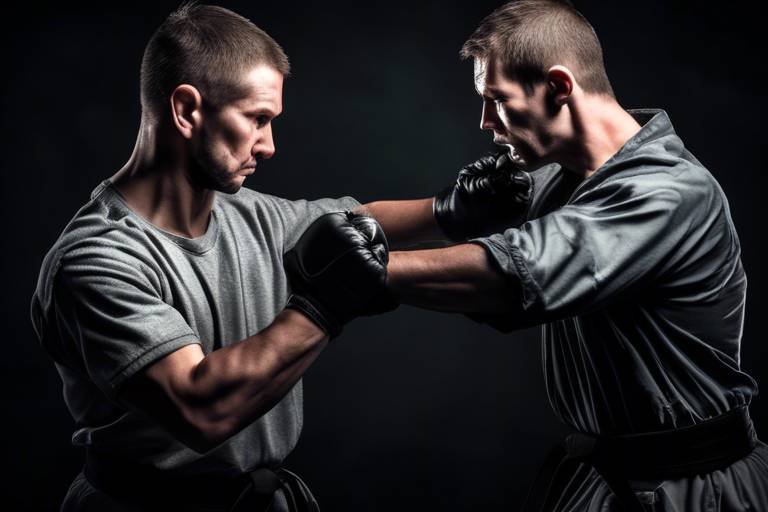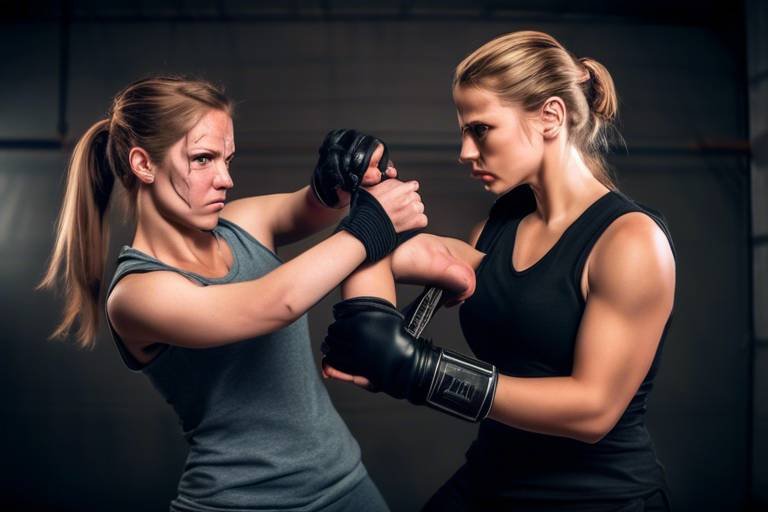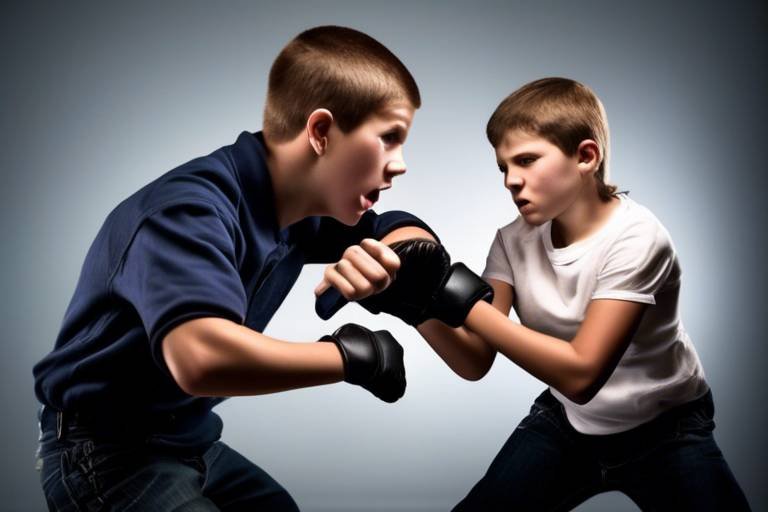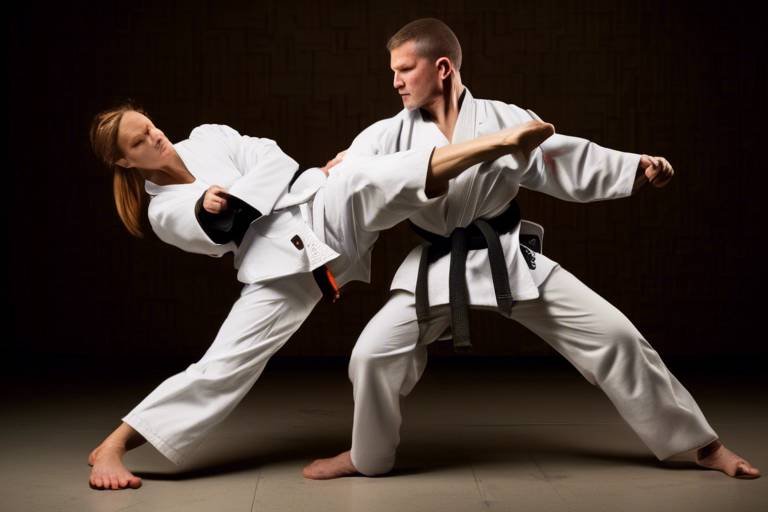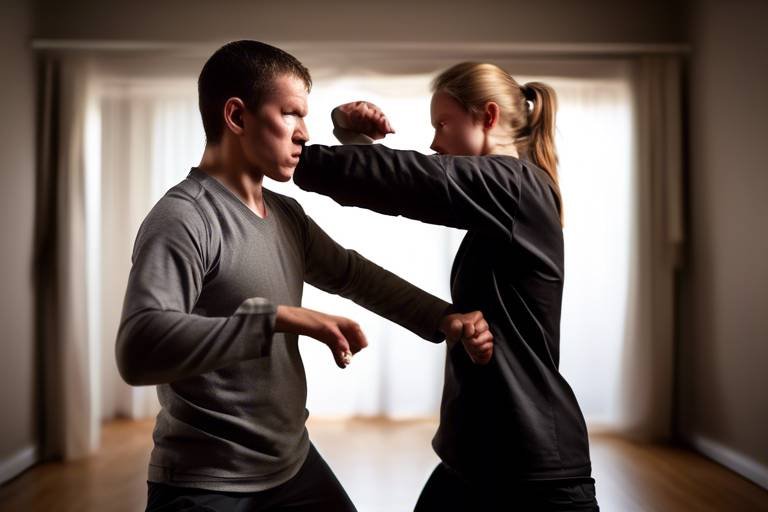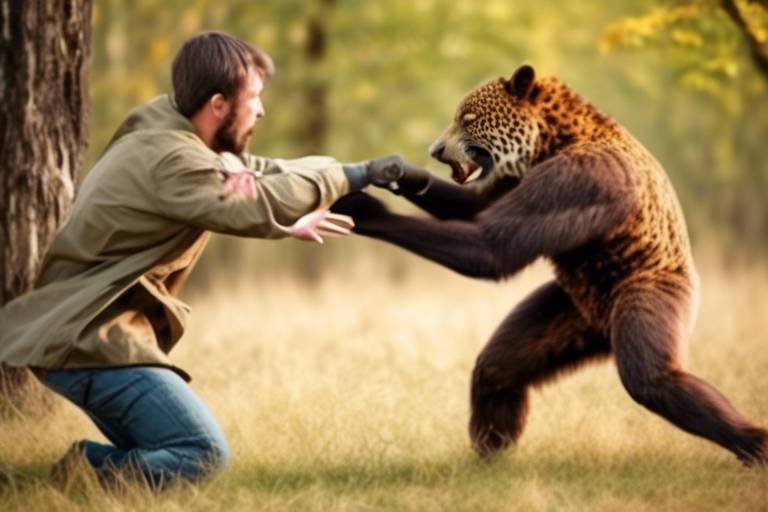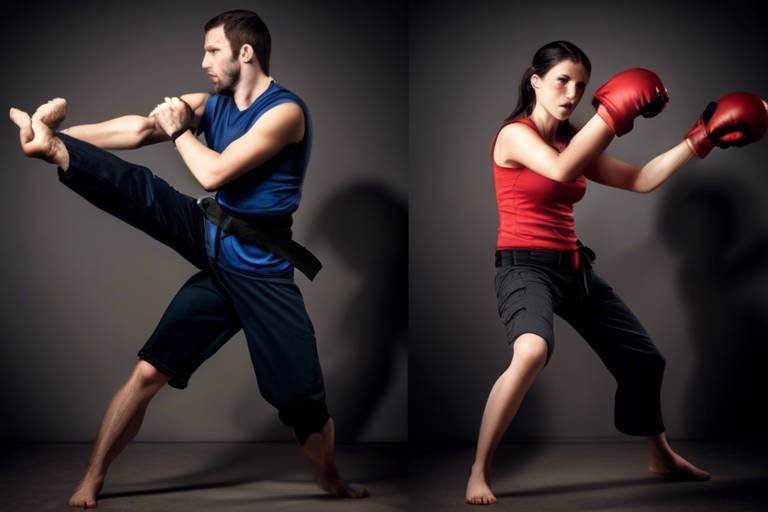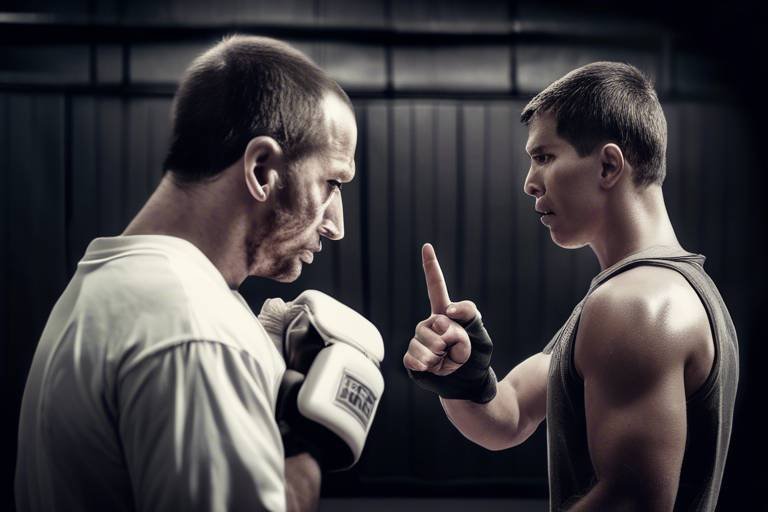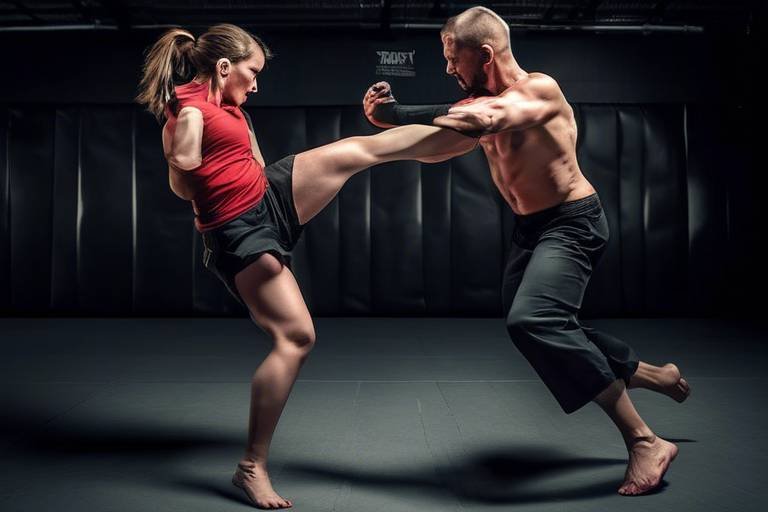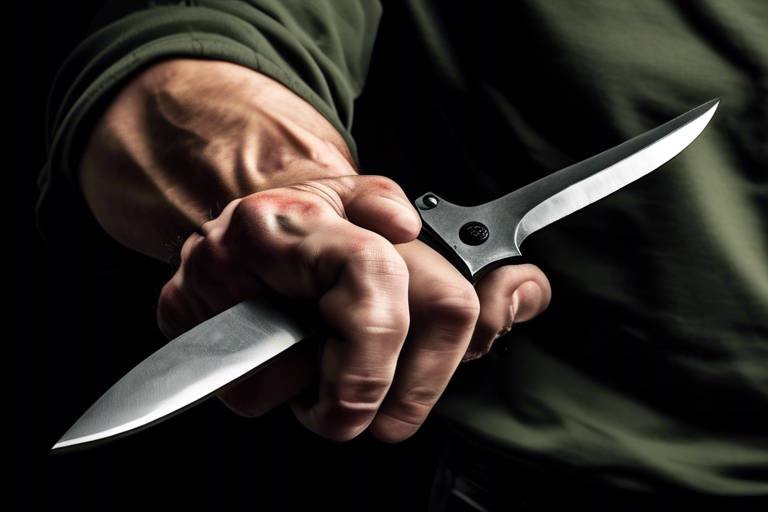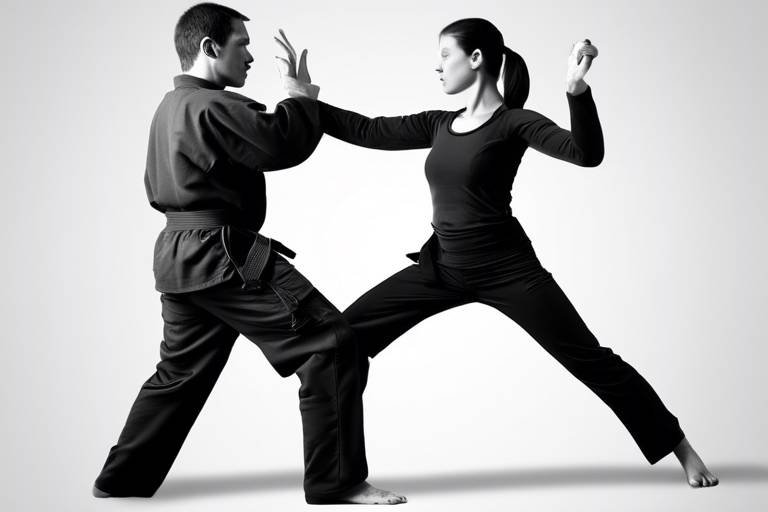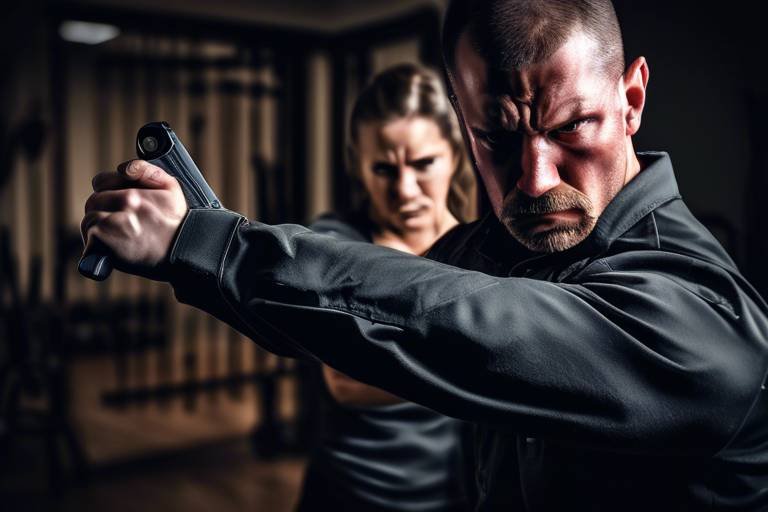Self-Defense Techniques That Really Work in Real-time Conflicts
In a world where personal safety can sometimes feel like a game of chance, knowing how to defend yourself effectively is not just a skill; it’s a necessity. The reality of real-time conflicts can be both shocking and overwhelming. But fear not! With the right techniques and mindset, you can turn the tide in your favor. This article dives deep into practical self-defense strategies that are not only effective but also easy to grasp and apply in stressful situations. From understanding the basics to mastering specific techniques, we’ve got you covered.
Before diving into the nitty-gritty of self-defense techniques, it’s crucial to understand the foundational principles that underpin them. Self-defense is not just about physical prowess; it’s about awareness, prevention, and knowing when and how to act. Awareness is your first line of defense. It’s about being conscious of your surroundings and recognizing potential threats before they escalate. Prevention comes next; it’s about taking proactive measures to avoid dangerous situations altogether. Lastly, understanding the legal implications of using force is essential—after all, knowing your rights can make a significant difference in how you handle a situation.
Imagine walking through a park, earbuds in, completely absorbed in your playlist. Now, what if I told you that this could be the exact moment when your awareness slips, making you vulnerable? Developing situational awareness is about tuning in to your environment. It’s about recognizing that the world is full of cues—both verbal and non-verbal—that can signal danger. Learning to trust your instincts can help you avoid conflicts before they even begin. This section will guide you through the importance of being vigilant and the strategies to enhance your awareness.
Body language speaks volumes, often more than words ever could. When it comes to self-defense, being able to read non-verbal cues can be your best friend. For instance, if someone approaches you with a tense posture, clenched fists, or an intense stare, these may be signs that they are not approaching with friendly intentions. Recognizing these signs early can allow you to de-escalate the situation or remove yourself from it entirely. The ability to interpret body language effectively can mean the difference between a peaceful interaction and a potentially dangerous confrontation.
Understanding common signs of aggression can be a game changer. Here are a few key indicators to watch for:
- Clenched fists: A clear sign that someone is ready to fight.
- Intense eye contact: This can often be a challenge or a threat.
- Rapid breathing: This can indicate heightened emotions, often anger.
- Invading personal space: If someone is getting too close too quickly, it’s a red flag.
By being aware of these signs, you can take proactive steps to defuse tension before it escalates into violence.
Knowing where to find safe spaces in your environment is crucial. Safe spaces can be anything from a crowded area, like a café or store, to a well-lit public space where you can find help. Here are some tips on identifying these spaces:
- Look for places with a lot of foot traffic.
- Identify locations with security personnel or cameras.
- Know the layout of your surroundings so you can escape if needed.
Having this knowledge can provide you with options and peace of mind, knowing that you have places to turn to in case of an emergency.
Now that we've laid the groundwork, let’s dive into some effective self-defense techniques. These techniques range from simple strikes to holds and escapes that can be employed in real-time conflicts. One of the most effective techniques is the use of pressure points. By targeting specific areas on an aggressor's body, you can incapacitate them momentarily, giving you the chance to escape. Additionally, learning basic striking techniques, such as palm strikes or elbow strikes, can be invaluable. Remember, the goal is not to engage in a prolonged fight but to create an opportunity to get away safely.
In addition to physical techniques, having the right self-defense tools can enhance your safety. From pepper spray to personal alarms, the options are vast. However, it’s essential to choose tools that you feel comfortable using and that comply with local laws. Each tool has its pros and cons, so take the time to research what might work best for you.
Understanding the legal implications of using self-defense tools is critical. Different regions have varying laws surrounding self-defense and the use of force. It’s vital to know your rights and the legal ramifications of your actions. For instance, using excessive force can lead to serious legal consequences, so it’s essential to act within the bounds of the law.
Finally, regular training and practice are vital for effective self-defense. Just like any skill, the more you practice, the better you become. Enrolling in self-defense classes can provide you with hands-on experience and build your confidence. The more familiar you are with techniques and tools, the more instinctive your reactions will be in a real-life scenario. After all, practice makes perfect!
Q1: Do I need to be physically strong to defend myself?
A1: Not necessarily! Self-defense relies more on technique and awareness than brute strength. Many techniques can be effective regardless of your physical size.
Q2: What should I do if I feel threatened?
A2: Trust your instincts. If you feel threatened, try to remove yourself from the situation as quickly as possible. Look for safe spaces or call for help.
Q3: Are self-defense classes worth it?
A3: Absolutely! Self-defense classes not only teach you techniques but also build confidence and awareness, making you less likely to be targeted.
Q4: Can I legally carry self-defense tools?
A4: This varies by location. Always check local laws regarding the possession and use of self-defense tools to ensure you’re compliant.

Understanding the Basics of Self-Defense
When it comes to self-defense, the first step is to grasp the fundamental principles that underpin effective strategies. Self-defense isn't just about physical techniques; it’s a holistic approach that encompasses awareness, prevention, and understanding the legal implications of using force. To truly defend yourself, you need to be equipped with the right mindset, knowledge, and skills. Think of it like building a house; without a solid foundation, the structure is bound to crumble. Similarly, without understanding these basics, your self-defense efforts may fall short.
Awareness is your first line of defense. It means being conscious of your surroundings and the people in them. Imagine walking through a crowded street; instead of being glued to your phone, take a moment to observe the environment. Are there groups of people acting suspiciously? Is anyone following you? By staying alert, you can often avoid dangerous situations before they even arise. Prevention goes hand-in-hand with awareness. It’s about making choices that minimize your risk. For instance, if you notice a poorly lit alley, opt for a well-lit path instead. This proactive approach can be your best defense.
Now, let’s not forget the legal side of things. Knowing when and how you can legally defend yourself is crucial. Laws vary from one place to another, and what might be considered self-defense in one jurisdiction could lead to serious legal consequences in another. It's essential to familiarize yourself with the laws in your area regarding self-defense. For example, in some regions, using a weapon in self-defense may only be justified when there’s an imminent threat to your life. Understanding these nuances can save you from unnecessary legal troubles.
To wrap it up, mastering the basics of self-defense involves a blend of awareness, prevention, and legal understanding. It’s not just about knowing how to throw a punch or escape a hold; it's about cultivating a mindset that prioritizes safety and preparedness. Just like a chess player anticipates their opponent’s moves, you too should be able to foresee potential threats and respond accordingly. Remember, the goal of self-defense is not just to fight back, but to avoid conflict whenever possible.

Situational Awareness and Prevention
In the world we live in, being aware of your surroundings is not just a good habit; it's an essential skill that can significantly enhance your personal safety. Situational awareness involves understanding the dynamics of your environment and recognizing potential threats before they escalate into dangerous situations. Think of it as having a sixth sense that alerts you to danger, allowing you to react appropriately. The key is to be proactive rather than reactive. Instead of waiting for a conflict to arise, you should cultivate an instinctive ability to avoid it altogether.
One effective way to boost your situational awareness is to develop a habit of scanning your environment regularly. This means taking a moment to observe the people around you, noting their behavior, and identifying anything that seems out of the ordinary. For instance, if you’re walking down the street and notice someone lingering too long in a doorway or behaving unusually, your internal alarm should go off. This awareness can be the difference between a safe exit and a potential confrontation.
Moreover, situational awareness is not just about looking for threats; it’s also about understanding how to prevent conflicts. This involves recognizing the places you frequent and identifying safe spaces where you can retreat if necessary. Safe spaces could be well-lit areas, busy shops, or even public transportation hubs. Knowing where to go can provide you with a sense of security and a plan of action if things go sideways. Here are some tips to help you identify safe spaces:
- Familiarize yourself with your surroundings: Regularly visit and assess the areas you frequent.
- Look for exits: Always be aware of the nearest exit in any environment.
- Seek help: Identify places where you can find assistance, such as police stations or busy businesses.
Another crucial component of situational awareness is understanding body language. Many confrontations can be predicted by reading the non-verbal cues of those around you. For example, if someone approaches you with a tense posture, clenched fists, or a fixed stare, these could be signs of aggression. Recognizing these signs early can give you the upper hand in deciding how to respond. By staying alert to body language, you can de-escalate potential conflicts before they turn violent.
In addition to reading body language, it's important to trust your instincts. If something feels off, it probably is. Your gut feelings are often based on subconscious observations that your brain picks up on. So, if you feel uneasy in a situation, it’s wise to take precautions—whether that means leaving the area, calling a friend, or seeking help. Remember, it’s better to be safe than sorry. Prevention is always better than cure, especially when it comes to your personal safety.
Lastly, practicing situational awareness is like training a muscle; the more you do it, the stronger it becomes. Start by incorporating small habits into your daily routine, such as being mindful of your surroundings while walking or paying attention to the behavior of people in public spaces. With time, you’ll find that your ability to assess situations improves, and you’ll feel more confident in your ability to prevent conflicts before they arise.

Reading Body Language
When it comes to self-defense, one of the most powerful tools at your disposal is the ability to read body language. This skill can be the difference between avoiding a conflict and finding yourself in a dangerous situation. Body language speaks volumes; it can reveal a person's intentions even before they utter a word. Think of it as a silent conversation that happens in the blink of an eye. For instance, if someone approaches you with a tense posture, clenched fists, or a furrowed brow, these are often indicators of aggression or hostility.
Understanding these non-verbal cues can arm you with the knowledge to de-escalate potential confrontations. Imagine walking down the street and noticing someone who seems overly agitated—perhaps they're pacing back and forth or making erratic movements. Recognizing these signs early can allow you to change your path or find a safe space before things escalate. It's like having a sixth sense that keeps you one step ahead.
To help you navigate these situations better, here are some common signs of aggression you should watch for:
- Clenched fists: This is often a precursor to physical confrontation.
- Direct eye contact: While eye contact can be a sign of confidence, an intense stare can indicate a challenge.
- Puffed chest or aggressive posture: This can signal that someone is trying to assert dominance.
- Rapid movements: Quick, jerky gestures can suggest agitation or impatience.
However, not all body language is aggressive. Sometimes, people may exhibit behaviors that indicate they are feeling threatened or scared. For example, if someone is avoiding eye contact, crossing their arms defensively, or backing away from you, these signs suggest that they may be feeling insecure or afraid. Recognizing these distinctions can help you tailor your response appropriately. You might choose to approach them calmly or give them space, depending on the situation.
In addition to recognizing aggressive signals, it's equally important to understand the context in which these behaviors occur. For example, a person who appears anxious in a crowded area might not be a threat but rather someone who is uncomfortable in their environment. This nuance is crucial for accurately interpreting body language. Just like a detective piecing together clues, you need to consider the whole picture before jumping to conclusions.
Moreover, developing your ability to read body language can significantly enhance your situational awareness. By observing the people around you, you can better gauge the atmosphere and identify potential risks before they become a reality. It’s like being a radar that picks up on subtle changes in your environment. This awareness not only helps you avoid dangerous situations but also equips you to respond effectively if a confrontation does arise.
So, the next time you're out and about, take a moment to observe the body language of those around you. It could be the key to staying safe and avoiding conflicts altogether. Remember, while words can be misleading, the body rarely lies.
- What are some effective ways to improve my ability to read body language? Practice observing people in various settings, and try to interpret their emotions based on their posture, gestures, and facial expressions.
- Can body language be misinterpreted? Yes, context is crucial. Always consider the situation and the individual's background before jumping to conclusions based on body language alone.
- How can I use body language to my advantage in self-defense? By projecting confident body language yourself, you can deter potential aggressors. Stand tall, maintain eye contact, and avoid closed-off postures.

Common Signs of Aggression
Recognizing can be a game-changer when it comes to personal safety. Imagine walking down the street and noticing someone approaching you with a tense posture and clenched fists. This is not just an innocent stroll; it's a clear indication that something might be off. Aggression often manifests through body language and facial expressions, which can serve as early warning signs. By being aware of these cues, you can better prepare yourself to either de-escalate the situation or remove yourself from it entirely.
Some typical signs to watch for include:
- Clenched Fists: A person with clenched fists is often ready to strike. This is a classic sign of someone who may be on the verge of losing their temper.
- Intense Staring: If someone is glaring at you or making prolonged eye contact, they may be challenging you or feeling threatened.
- Rapid Breathing: Increased heart rate and quickened breaths can indicate rising anger or agitation.
- Hostile Posture: An aggressive stance—like standing with feet planted firmly apart and leaning forward—can suggest readiness to confront.
- Verbal Cues: Yelling, swearing, or using a harsh tone can also signal that someone is agitated and potentially aggressive.
It’s important to note that not all signs are obvious, and sometimes, aggression can be subtle. For instance, someone may not exhibit overtly hostile behavior but could still pose a threat. This is where situational awareness comes into play. By tuning into your surroundings and the behavior of those around you, you can often sense when something feels off. Trust your instincts; if a situation feels uncomfortable, it probably is.
Moreover, being proactive can help you avoid dangerous encounters. If you notice someone displaying these signs, consider your options: can you walk away? Is there a nearby safe space? Keeping your distance and remaining calm can sometimes de-escalate tension before it escalates into a conflict. Remember, your safety is the priority, and recognizing these signs early can be the difference between a peaceful resolution and a potentially dangerous confrontation.

Identifying Safe Spaces
When it comes to self-defense, one of the most crucial aspects is knowing how to identify safe spaces in your environment. These are places where you can seek refuge or find help during a conflict. Imagine being in a crowded area and sensing danger; your instinct should guide you to the nearest safe space, whether it’s a store, a public building, or even a group of people. The ability to quickly pinpoint these locations can significantly enhance your personal safety.
Safe spaces can vary depending on your surroundings, but there are common features that make a location a good refuge. Ideally, a safe space should be:
- Accessible: It should be within a reasonable distance from where you are.
- Populated: A place with other people can deter aggressors.
- Visible: Areas that are well-lit and open can provide a sense of security.
- Secure: Look for places that can be locked or have security personnel present.
Consider familiarizing yourself with the layout of places you frequent, such as shopping malls, parks, or your workplace. For instance, in a shopping mall, identify the nearest exits, security desks, or stores that are likely to be busy. In a park, note where the main pathways lead and where people tend to gather. This mental map can be a lifesaver in a tense situation.
Additionally, it’s important to practice situational awareness. This means not just identifying safe spaces but also being aware of your surroundings at all times. Pay attention to who is around you and how they’re acting. If something feels off, don’t hesitate to move towards a safe space. Trust your instincts; they can often guide you better than any plan you might have.
In conclusion, knowing how to identify safe spaces is a vital self-defense strategy. It’s not just about physical techniques; it's about being mentally prepared and aware of your environment. By taking the time to learn and recognize these areas, you empower yourself to make quick decisions that can protect you in real-time conflicts.
Q1: What should I do if I can't find a safe space?
A1: If you can't find a safe space, try to remain calm and look for ways to de-escalate the situation. Avoid confrontation and seek to move towards populated areas where help may be available.
Q2: Are there specific places I should avoid?
A2: Yes, try to avoid isolated areas, poorly lit spaces, or places where you feel uncomfortable. Always opt for well-populated and well-lit environments.
Q3: How can I improve my situational awareness?
A3: Practice being mindful of your surroundings. Take note of people, exits, and potential safe spaces as you move through different environments. Regularly assess your environment, especially in unfamiliar places.

Effective Self-Defense Techniques
When it comes to self-defense, having a repertoire of effective techniques can be a game changer in real-time conflicts. The key is to focus on methods that are not only practical but also easy to remember under pressure. Think of self-defense as a toolbox; each technique is a different tool that can help you navigate various situations. Whether you find yourself in a crowded area or a secluded spot, being equipped with the right skills can make all the difference.
One of the most fundamental techniques is the strike. Striking can take many forms, from punches to kicks, and is often the quickest way to create distance between you and an aggressor. However, it’s not just about brute force; it’s about targeting vulnerable areas of the body. For instance, aiming for the eyes, nose, or groin can incapacitate an attacker long enough for you to escape. Remember, the goal is not to engage in a prolonged fight but to create an opportunity to get away.
Another essential technique is the hold. This can be particularly useful if an assailant grabs you. Techniques such as wrist locks or joint manipulations can help you break free from an attacker’s grip. It’s crucial to practice these moves regularly, as muscle memory plays a significant role in executing them effectively. Think of it like learning to ride a bike; the more you practice, the more instinctual it becomes.
Now, let’s not forget about the importance of escapes. If you find yourself in a situation where you’re being held or restrained, knowing how to escape is vital. Techniques like the “shrug and step” can help you slip out of an attacker’s grasp. This involves shrugging your shoulders to break their grip while simultaneously stepping away. It’s all about creating that moment of separation, allowing you to make your escape.
In addition to these techniques, it’s essential to incorporate elements of mental preparedness into your self-defense training. This means being aware of your surroundings and having a plan in case of an emergency. Visualization techniques can be beneficial here; picture yourself successfully using these self-defense moves in various scenarios. This mental rehearsal can boost your confidence and readiness when faced with a real threat.
Finally, remember that self-defense is not just about physical techniques. It also involves using your voice. Shouting for help or using assertive language can deter an attacker and attract attention. Consider it your verbal weapon; it can be just as effective as any physical move. In many cases, the loudness of your voice can surprise an aggressor, giving you the precious seconds you need to escape.
To summarize, effective self-defense techniques encompass a range of actions, from strikes and holds to escapes and assertive communication. It’s about being prepared both physically and mentally. Regular training, practice, and situational awareness are your best allies in enhancing personal safety. Remember, the goal is to protect yourself and escape unharmed, not to engage in a fight.
- What is the best self-defense technique for beginners?
For beginners, simple strikes to vulnerable areas like the eyes or groin, along with basic escape techniques, are highly effective.
- How often should I practice self-defense techniques?
Regular practice, ideally once a week, helps reinforce muscle memory and increases confidence in your abilities.
- Can self-defense techniques be learned online?
While online resources can provide valuable information, hands-on training with a qualified instructor is essential for mastering techniques.
- Are self-defense tools necessary?
While not strictly necessary, tools like pepper spray can provide an extra layer of security when used responsibly.

Choosing the Right Self-Defense Tools
When it comes to personal safety, having the right self-defense tools can make a world of difference. Imagine walking down a dimly lit street, and suddenly you feel uneasy. What do you do? This is where self-defense tools come into play, acting as your safety net. Whether you're a seasoned martial artist or just someone looking to boost your confidence, understanding which tools to choose is crucial. The right self-defense equipment not only empowers you but can also deter potential threats before they escalate into a dangerous situation.
There are various self-defense tools available on the market, each serving a unique purpose. Some of the most popular options include:
- Pepper Spray: An effective deterrent that can incapacitate an attacker temporarily, giving you a chance to escape.
- Personal Alarms: Loud and attention-grabbing, these devices can alert others nearby when you're in danger.
- Tactical Flashlights: Not only useful for illumination, but they can also temporarily blind an assailant, allowing you to flee.
- Self-Defense Keychains: Compact and easy to carry, these can be used for striking or as a distraction.
However, selecting the right tool goes beyond just knowing what's out there. It's about considering your personal needs, the legality of the tool in your area, and how comfortable you feel using it. For instance, while pepper spray is a popular choice, some people might prefer a personal alarm due to its non-violent nature. It’s essential to choose a tool that aligns with your instincts and comfort level.
Another critical factor to consider is the legal implications of carrying self-defense tools. Laws regarding self-defense vary widely from one place to another. Some areas may have restrictions on the size and type of pepper spray you can carry, while others may prohibit certain weapons altogether. It's vital to research local laws to ensure that you are compliant and to avoid any potential legal troubles. Remember, being prepared also means being informed.
Once you've chosen your self-defense tools, the next step is to practice using them. Just like with any skill, regular training can enhance your effectiveness in a real-life situation. Familiarize yourself with how your tools work and develop strategies for using them in different scenarios. This not only builds muscle memory but also boosts your confidence. After all, when the moment of truth arrives, you want to react instinctively, not hesitate.
In conclusion, choosing the right self-defense tools is about finding what works best for you while being mindful of the legal landscape. With the right tools in your arsenal and the knowledge of how to use them, you can enhance your personal safety and navigate potentially dangerous situations with greater confidence. Remember, self-defense is not just about physical tools; it’s about empowering yourself with knowledge and preparedness.
Q: What is the best self-defense tool for beginners?
A: For beginners, personal alarms and pepper spray are often recommended due to their ease of use and effectiveness. They require minimal training and can provide immediate assistance in a threatening situation.
Q: Are self-defense tools legal everywhere?
A: No, laws vary significantly by location. It’s essential to check the local regulations regarding the possession and use of self-defense tools in your area.
Q: How can I practice using my self-defense tools?
A: Consider enrolling in self-defense classes that incorporate the use of your chosen tools. Alternatively, you can practice at home in a safe environment, ensuring you understand how to deploy them effectively.

Legal Considerations
When it comes to self-defense, understanding the legal landscape is just as essential as mastering the physical techniques. You might be wondering, "What happens if I have to defend myself?" or "Will I get in trouble for using force?" These questions are crucial because the laws surrounding self-defense can vary significantly from one place to another. In many jurisdictions, the law allows for self-defense, but there are specific conditions that must be met for it to be justified.
First and foremost, the principle of proportionality is key. This means that the level of force you use in self-defense must be proportionate to the threat you are facing. For example, if someone is merely pushing you, responding with lethal force could land you in legal trouble. Instead, you should aim for techniques that allow you to escape the situation without escalating the conflict unnecessarily.
Additionally, the concept of imminent threat comes into play. You must be able to demonstrate that you were facing an immediate threat of harm. If you can clearly articulate that you acted out of fear for your safety, you may have a stronger legal standing. However, if the threat was not immediate or if you had the opportunity to retreat safely, the legal justification for your actions could weaken significantly.
It’s also important to consider the location where the incident occurs. Different states and countries have varying laws regarding self-defense. For example, some places have "stand your ground" laws, which allow individuals to use force without the duty to retreat, while others may require you to attempt to escape before resorting to self-defense. Here’s a quick comparison:
| Location | Stand Your Ground | Duty to Retreat |
|---|---|---|
| Florida | Yes | No |
| New York | No | Yes |
| California | Yes | No (in some situations) |
Lastly, remember that using self-defense tools, such as pepper spray or personal alarms, comes with its own set of legal considerations. While these tools can be effective for personal safety, their use is often regulated. For instance, some areas may have restrictions on the size or type of pepper spray you can carry, and using these tools inappropriately could lead to criminal charges. Therefore, it’s vital to familiarize yourself with local laws regarding self-defense tools.
In conclusion, being prepared for a self-defense situation means not only knowing how to protect yourself physically but also understanding the legal ramifications of your actions. Always stay informed about the laws in your area, and consider consulting with a legal expert if you have specific questions or concerns. Remember, knowledge is power, and being aware of your rights can make a significant difference in any confrontation.
- What is self-defense? Self-defense refers to the right to protect oneself from harm using reasonable force.
- When is it legal to use self-defense? It is legal to use self-defense when facing an imminent threat of harm and the force used is proportional to that threat.
- Do I need to retreat before using self-defense? This depends on local laws; some places have a duty to retreat, while others allow you to stand your ground.
- Are self-defense tools legal? The legality of self-defense tools like pepper spray varies by location, so it's essential to check local laws.

Training and Practice
When it comes to self-defense, are not just options; they are necessities. Imagine trying to ride a bike without ever having practiced balancing or pedaling. It’s the same with self-defense techniques—without regular practice, your skills can become rusty, and your confidence may wane. Engaging in self-defense training not only equips you with the techniques to protect yourself but also builds your mental fortitude. This mental preparedness is just as crucial as the physical skills you learn.
So, where do you start? First, consider enrolling in a self-defense class. These classes often provide structured environments where you can learn various techniques under the guidance of experienced instructors. They teach you how to respond to different situations, from simple verbal de-escalation tactics to more physical responses if necessary. Make sure to choose a class that focuses on real-world scenarios, as these will give you the most applicable skills. Here’s a quick overview of what to look for in a good self-defense class:
| Criteria | Description |
|---|---|
| Instructor Experience | Look for instructors with real-life experience in self-defense or law enforcement. |
| Curriculum Focus | Ensure the curriculum emphasizes practical techniques and situational awareness. |
| Class Size | Smaller classes often allow for more personalized attention and feedback. |
| Reputation | Check reviews or ask for recommendations to find a reputable school. |
Once you’ve found a class and started training, consistency is key. Try to practice at least once a week. This regular engagement helps solidify the techniques in your muscle memory, so when the time comes to use them, they come naturally. You might also consider practicing with a partner. This can help simulate real-life scenarios and enhance your response time. Remember, self-defense isn’t just about the physical; it’s also about mental preparedness. The more you practice, the more confident you’ll feel in your ability to handle unexpected situations.
In addition to formal classes, there are plenty of resources available online. YouTube and other platforms host a myriad of self-defense tutorials. However, be cautious and ensure that the content is from reputable sources. Watching videos can be a great supplement to your training, but it shouldn’t replace hands-on practice. Think of it as learning the theory before you get behind the wheel of a car—you need both knowledge and practice to truly master the skill.
Lastly, consider joining a local self-defense community or forum. Engaging with others who share your interests can provide motivation and encouragement. You might even find a training partner through these networks, which can make practicing more enjoyable. Remember, self-defense is a journey, not a destination. Every bit of training you undertake is a step towards greater safety and confidence.
- How often should I practice self-defense techniques? Aim for at least once a week to maintain your skills.
- Can I learn self-defense online? Yes, but practical, hands-on training is essential for effective learning.
- What should I look for in a self-defense instructor? Look for experience, a good curriculum, and positive reviews.
- Is self-defense training suitable for everyone? Absolutely! Self-defense techniques can be adapted for all ages and fitness levels.
Frequently Asked Questions
- What are the most effective self-defense techniques?
Effective self-defense techniques include strikes, holds, and escapes. Techniques like the palm strike, knee to the groin, and wrist escapes can be particularly useful in real-time conflicts. The key is to focus on techniques that are simple, efficient, and can be executed quickly under stress.
- How can I improve my situational awareness?
Improving situational awareness involves being mindful of your surroundings and recognizing potential threats. Regularly practice scanning your environment, noting exits, and observing people's body language. It’s like being a detective in your own life—always looking for clues that might indicate danger.
- What should I do if I feel threatened?
If you feel threatened, trust your instincts and prioritize your safety. Try to remove yourself from the situation if possible. If you can’t escape, use verbal de-escalation techniques to calm the aggressor or prepare to defend yourself if necessary. Remember, it’s about staying safe, not proving a point.
- Are self-defense tools like pepper spray legal?
Yes, self-defense tools such as pepper spray are legal in many areas, but laws can vary significantly by location. It's crucial to check your local laws regarding the possession and use of self-defense tools to ensure you are compliant and understand the legal implications.
- How often should I practice self-defense techniques?
Regular practice is essential for retaining self-defense skills. Aim for at least once a week to keep techniques fresh in your mind and build muscle memory. Think of it like any sport—consistent practice leads to improved performance and confidence when it matters most.
- What are some common signs of aggression to look out for?
Common signs of aggression include clenched fists, hostile postures, and intense eye contact. Recognizing these cues can help you identify potential threats before they escalate. It's like reading a book—once you know the signs, the story becomes much clearer.
- How can I identify safe spaces in my environment?
To identify safe spaces, look for well-lit areas, places with a lot of people, or locations with security personnel. Think of safe spaces as your personal hideouts—places you can retreat to if things go sideways. Familiarizing yourself with these locations can make all the difference in a crisis.

